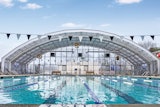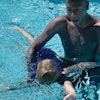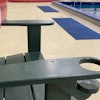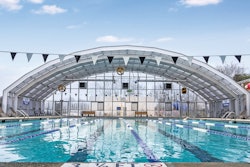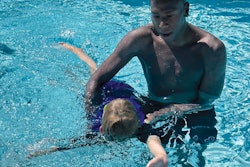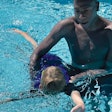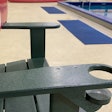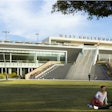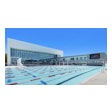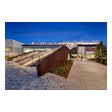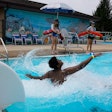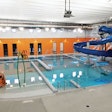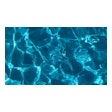Steve Crocker chuckles at the recollection. While doing a final walkthrough of a college aquatics facility on which his consulting firm, Counsilman-Hunsaker, had worked - its first project involving color-changing LED light fixtures - Crocker struck up a conversation with a lifeguard.
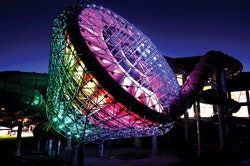 TORNADO WARMING Great Wolf Lodge water parks use color-changing LED lighting to enhance the visual appeal of attractions. (Photo of Great Wolf Lodge, Grand Mound, Wash., courtesy of Water Technology Inc.)
TORNADO WARMING Great Wolf Lodge water parks use color-changing LED lighting to enhance the visual appeal of attractions. (Photo of Great Wolf Lodge, Grand Mound, Wash., courtesy of Water Technology Inc.)"I was having a good time chatting with him, and he says, 'So, we're a Methodist school, and we've got a 35-person hot tub with mood lights.' Mood lights. I thought that was a funny way to look at it."
More than a mood enhancer, LED lighting has — within a mere half-dozen years — become a full-fledged aquatics industry movement. Says Crocker, Counsilman-Hunsaker's Midwest studio director, "We don't do anything but LEDs."
The reason is efficiency. Today's LED fixtures (LED stands for light-emitting diode) are designed to produce the same amount of light as a 500-watt incandescent bulb, for example, while drawing no more than 75 watts, a fact that many building codes dictating wattage per square foot of pool surface are just starting to embrace by specifying lumens output instead. That each LED bulb costs roughly twice what traditional alternatives cost should not serve as a deterrent, according to Greg Fournier, of Hayward Pool Products' project management team. "The reason that people want to do this is they're looking at payback on their investment, normally in less than two years," Fournier says. "They're putting in new technology that really pays for itself."
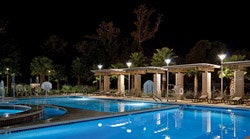
Adds Jim Drozdowski, sales manager for institutional pools at Pentair Pool Products Inc., "The great thing about LED lighting is that you can save up to 86 percent of the energy costs without any compromise in terms of light intensity."
Moreover, LED lights will likely outlive their counterparts tenfold - providing 20,000 hours of service versus 2,000. "One thing that a lot of people forget is the cost, the man hours, associated with relamping," Crocker says. "Basically, to relamp the old type of fixture, a person has to get in the water with a screwdriver, unscrew the face of that thing and pull the lamp out. It would have enough extra cord in the housing that they could pull the lamp to the surface and then relamp it. The additional cost of an LED is negated the very first time you have to relamp an incandescent fixture."
COLOR SPLASH
To date, color-changing LED technology, which cannot match the lumen output of white LEDs, has made its biggest splash in the residential pool market. "With regard to residential, it's all about color," Fournier says. "It's about transforming the backyard. Commercial spaces in many places are under the guidelines of the local health inspectors. They have commercial codes with regard to the amount of brightness that's necessary to properly illuminate a pool."
"There are many places where color lights are not allowed in commercial pools," Drozdowski says. "The reason that we don't do color pools is not because it wouldn't look beautiful - because it would - but because the codes and regulations are really pointed toward white light."
LED colors are a natural fit for the recreational aquatics market, however. Melinda Kempfer, who handles business development for aquatics planning, design and engineering firm Water Technology Inc., points to water park attractions that use colored lighting to change the - here's that word again - mood. "They're using them for theming, for holidays," says Kempfer, citing the Howlin' Tornado at Great Wolf Lodge in Wisconsin Dells as one example. "The entire tornado slide is covered with LED lights, and it consumes very little power. On the Fourth of July, they turn the whole thing red, white and blue."
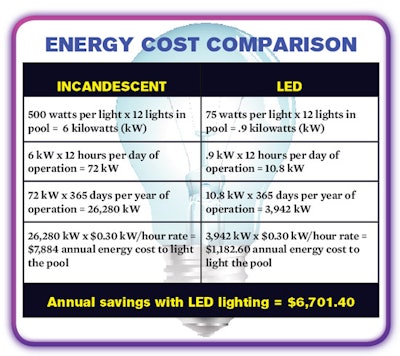
'OBVIOUS DECISION'
LED pool lighting continues to evolve. In addition to launching production of lights with the same lumen output as 500-watt incandescent bulbs within the past year, manufacturers are making bulb types completely interchangeable without having to reconfigure the fixture housing - allowing pools to be more easily retrofitted with LED technology.
Manufacturers are also looking to make the technology ever more affordable. "There are utility companies that do have rebates for putting in LED-style lighting," Fournier says. "Not many right now, but we're pushing for that."
Compared to the electricity required to run a pool's pumps, lighting consumes a relatively small but still "not negligible" amount of energy, according to Crocker. Adds Roderick, "With the push toward LEED and energy efficiency, people are doing whatever they can to either achieve those points or to save on energy. It's definitely an advantage."
And the advantages don't end there. "They really do look a lot nicer," Crocker says of LED lights. "It's white light that makes the pool really look blue, as opposed to yellowish. It's a pretty obvious decision."
Must-Have Underwater Illumination
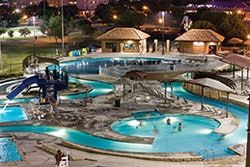
Within the natatorium setting, overhead lighting is typically sufficient to illuminate the pool, and experts agree that clear water trumps in-pool lighting in terms of enhancing guarding effectiveness and user safety. For that reason and others (think swimmer distraction), in-pool lighting is not a common specification for competition pools. "The NCAA rulebook, the USA Swimming rulebook and even the high school rulebook all state that you need 100 foot-candles of overhead light, and to be honest that rarely occurs, because it's a near-ridiculous amount of light," says Counsilman-Hunsaker studio manager Steve Crocker. "A lot of electrical engineers say that you can do surgery with 100 foot-candles of light."
Crocker adds that competition facilities that host high-end meets, especially those that are televised, should adhere to the rulebooks, but he has recommended far less overhead lighting - 60 foot-candles, say - in high school pools. He's even seen some college facilities make do with lighting outputs of less than 30 foot-candles.
That said, in-pool lighting can be introduced to complement what's overhead. "Many codes will say, 'If you use underwater lights, you must have .5 watts per square foot of pool surface area,' but they don't require underwater lights," Crocker says. "Some codes will say, 'The pool must have lights from above, and a minimum of 30 foot-candles. If you have underwater lights at .5 watts per square foot, you only have to have 10 overhead.' So they allow you to reduce the amount of overhead lighting that's required, if you have underwater lighting."
Then there are commercial pool applications for which underwater illumination is a must. "I'm working on one now where we have a diving well that's 17 feet deep," says Joel Roderick, project designer at Water Technology Inc. "To get lighting all the way to the floor, you need to supplement. If you're going to have an outdoor pool and you're going to operate it at night, you would need underwater lights to supplement anything overhead. It's always a supplement to the overhead lighting."
"A lot of facilities like to do the 'dive-in movies' - put a big projector in there and play a movie on the wall, and everybody sits in their inner tubes and watches a movie," says Crocker. "If you're going to do something like that, it's mandatory that you have in-pool lighting. You couldn't do something like that safely any other way."
- P.S.
Case Study: Edmonds Pool and Community Centre
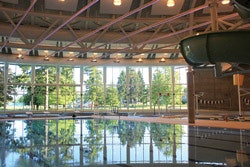
From its pairings of 37 white and color-changing fixtures underwater to its linear lighting overhead, the 25-meter, six-lane training tank at newly minted Edmonds Pool and Community Centre in Burnaby, B.C., is taking advantage of LED technology like few other facilities.
While it's not all that common for a lap pool to feature underwater lighting, Edmonds project stakeholders made the specification in the interest of programming flexibility. "Because it was mostly going to be for community use, they wanted to have some color-changing light fixtures in there," says Mary Chow, associate at British Columbia-based CEI Architecture. "They have a youth program that they knew would benefit from some sort of excitement in the lap pool itself. That was one of the main reasons why we went with the LED, because it allows us to do the color changing and it can be programmable, as well."
It's even less common, given the hassle of maintaining them, for light fixtures of any kind to be specified directly above the water surface, but the Edmonds pool incorporates overhead LED fixtures in a nod to its user swim teams.
"I know it's not ideal, but because of the geometry of the room itself - the space is actually a quarter-circle - and because they did want to use this for swim teams in training, they wanted something that was going to be directional," Chow says. "Usually what happens is you're doing your backstroke and you're looking up at the ceiling, and if you have ceiling beams, that's what people follow to stay inline. We suggested that horizontal bars be dropped down and fitted with LED lights that run parallel to the lanes. They're not high up in terms of the water surface, and the idea is that it's a strip light that runs from one end of the tank to the other. It's really just simply for swimmers who are doing the backstroke."
The lifespan of LED lighting made such a design decision much easier. "That was one of the things that we looked at for the in-pool lighting, as well - that it does have a longer life than a traditional incandescent light," says Chow. "It is something that we're using in our facilities a lot now. We're switching over, even if it is more expensive."
- P.S.










